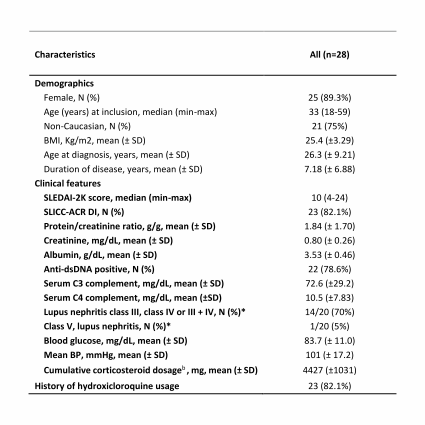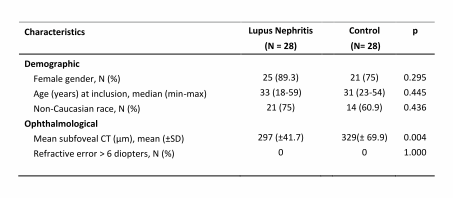Session Information
Session Type: Poster Session C
Session Time: 10:30AM-12:30PM
Background/Purpose: Lupus choroidopathy was reported to be a marker of severe systemic lupus erythematosus (SLE) activity, commonly associated with nephropathy. However, it remains controversial if the choroidal thickness (CT) is related to the glomeruli vasculature status and if it can provide additional indirect evidence of underlying lupus nephritis activity. Therefore, the purpose of the present study was to measure the choroidal thickness in patients with active lupus nephritis prior to the induction treatment and compare with a healthy control group.
Methods: This was a case-control cross-sectional study which evaluated 28 consecutive active lupus nephritis patients prior to induction treatment, who met the 2019 ACR/EULAR classification criteria for SLE, and nephritis was defined according to the American College of Rheumatology. Twenty patients had biopsy proven lupus nephritis (Renal Pathology Society/International Society of Nephrology). For the control group, healthy subjects were selected, balanced by sex and age with the study group. CT measures were obtained using the enhanced depth imaging protocol for choroid evaluation on spectral-domain optical coherence tomography.
Results: Patients and controls had comparable age (p=0.445) and female predominance (p=0.295). Renal parameters were characterized by median creatinine (0.80±0.26mg/dL) and elevated median protein/creatinine ratio (1.84±1.70 g/g). Histological classes were predominantly proliferative [14/20 (70%)]. The mean central subfoveal CT was reduced in patients compared to the healthy control (297±41.7μm vs. 329±69.9 μm, p=0.004).
Conclusion: The observed thinning of central subfoveal CT in patients with active lupus nephritis prior to induction treatment suggest that this vascular structure is an underrecognized target of concomitant systemic involvement in these patients. The easy and non-invasive access to this site justifies future longitudinal studies to define its possible utility as a clinical tool for SLE management and follow-up as well as an outcome measure for clinical trials.
BMI: body mass index; SLEDAI_2K: Systemic Lupus Erythematosus Disease Activity Index 2000; SLICC-ACR DI: systemic lupus international collaborating clinics American College of Rheumatology damage index; BP: blood pressure.
aData expressed as N (%), mean ± standard deviation (SD) and median (min-max).
b Including oral and endovenous usage of corticosteroid (prednisone and methylprednisolone).
*20 patients with renal biopsy with representative sample for classification of lupus nephritis by the International Society of Nephrology/Renal Pathology Society 2003.
Data expressed as N (%), mean ± standard deviation (SD) and median (min-max).
To cite this abstract in AMA style:
Kolachinski R Brandao L, Parente de Andrade L, do Rosário D, De Queiroz e Barbosa P, Formiga F, Torres Ribeiro C, Pedrosa T, Abalem de Sá Carricondo M, Carricondo P, Bonfa E, Remiao Ugolini Lopes M. Choroidal Thickness in Active Lupus Nephritis [abstract]. Arthritis Rheumatol. 2024; 76 (suppl 9). https://acrabstracts.org/abstract/choroidal-thickness-in-active-lupus-nephritis/. Accessed .« Back to ACR Convergence 2024
ACR Meeting Abstracts - https://acrabstracts.org/abstract/choroidal-thickness-in-active-lupus-nephritis/


